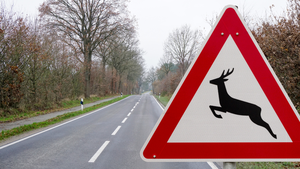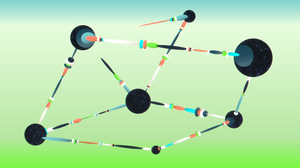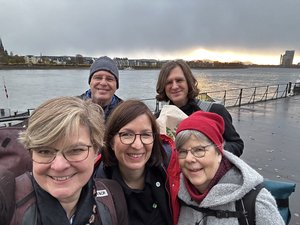Letting Data Speak

Making the potential of better available data tangible is not easy. In order to offer an exciting, accessible introduction to the topic, we have developed a new narrative form with partners from the NFDI4Biodiversity network: digital data stories. The first of these stories highlights how harmonized data can help to identify endangered species in good time – thus highlighting the potential of NFDI4Biodiversity.
Letting Data Speak: What the NFDI4Biodiversity Data Stories are all about
While other partner institutions contribute their own data or technical support, the Leibniz Institute for Regional Geography (IfL), based in Leipzig, supports the members of the consortium in developing new publication formats, among other things. The aim is to visualize biodiversity data itself or its mobilization within the consortium in order to enable new perspectives and thus facilitate understanding - which is not always a given with the complex topic of data. One of the formats created in this way is the data story told with the help of the storytelling tool Pageflow. Viewers can scroll through an article enriched with illustrations, maps, graphics and videos and get to know a topic in a more lively way than would be possible with text alone.
Recognizing Species Decline in Time – Thanks to Harmonized Data
The Data Story focuses on the freshwater fish bream and grayling. While the grayling is considered rare and highly endangered, the bream is still common in German waters. However, the populations of both species are declining – a finding made possible by an analysis based on the mobilization of occurrence data from various federal states. Against this background, the data story From reputation and reality – Why common fish species are also worth protecting illustrates the potential of a uniform and transnational organization of biodiversity data – and shows the enormous potential of the work being driven forward in NFDI4Biodiversity. The first Data Story was developed together with the German Centre for Integrative Biodiversity Research (iDiv) and the Red List Centre, which publishes the endangered lists for around 37,000 animal and plant species.
The Data in the Story: Background and Development
The data story Of reputation and reality – Why common fish species are also worth protecting is based on data collected as part of the European Water Framework Directive and the Flora-Fauna-Habitat Directive. In total, data was collected from 72 different fish species at over 12,000 sampling sites in 12 federal states. The study period extends from 1985 to 2020, with a particular focus on the years 2004 to 2020. Sampling was mainly carried out using electrofishing – an efficient method of fish stocktaking.
The two fish species in focus in this data story are the freshwater fish bream and grayling. The bream is common and is often considered less popular in the fish community, while the grayling is less common and is currently considered worthy of protection. The analysis of the above data revealed a more nuanced picture: even species that were previously considered common and for which no declines have been recorded in recent reports have been shown to be in decline.
On the one hand, the data story sheds light on the evaluation of the data – on the other hand, it discusses possible reasons and presents conceivable renaturation measures. The latter are aimed at providing fish with safe habitats and thus stabilizing stocks in the long term.

New perspectives: What Data Reveals – And What Not
A central concern of data history is to enable new perspectives on the mobilized and harmonized data set. A data-analytical approach aims not only to view the data in its entirety, but also to incorporate critical reflections on its quality, reliability and collection methodology, thereby shedding light on the potential, but also the limits of what data can tell us.
Main Addressees of the Data Stories: Data Enthusiasts and Managers
In order to optimally address the diverse target groups of NFDI4Biodiversity, four central personas were developed at an early stage as part of the public relations work: fictitious but conceivable real personalities who, with their information interests, act as representatives of a wide variety of target groups. Data manager Doro is particularly relevant for the data story format, as we assume that she has a keen interest in the possibilities and limitations of the underlying data.
In general, however, the story is aimed at all data enthusiasts who are enthusiastic about the potential that the sometimes seemingly dry topic of data holds. The integration of various media such as infographics, texts and videos, as well as the option for viewers to scroll through the story at their own pace, offer an easier introduction than conventional publication formats.
A particular research interest of the IfL is also to visualize uncertainties within the data and, in particular, to explore which content can be represented cartographically and which cannot. The aim is to convey a more realistic picture of scientific results and to make research more transparent for insiders and outsiders.
Another Story in Progress
As part of the collaboration between NFDI4Biodiversity and IfL, several prototypes of data stories have already been developed and presented at various events, including the NFDI4Biodiversity All Hands Conference 2024, where the format won the poster award (see follow-up report), the annual conference of the Initiative News-Infographics-Analytics-Maps (NIAM) 2024, the Research Data Days 2024 and the conference of the National Biodiversity Monitoring Center (NMZB) 2024. Fortunately, the format always met with interest and provided an opportunity to discuss the content of the story as well as the narrative format itself. A second data story, which is being created together with the Dachverband Deutscher Avifaunisten (DAA), is currently being finalized.
Contact
Author of the Data Story
Robert Köpke | Leibniz Institute for Regional Geography (IfL) | Research field: Geovisualization | r_koepke@leibniz-ifl.de
Public Relations NFDI4Biodiversity
Katharina Frohne | German Federation for Biological Data e.V. (GFBio) | kfrohne@gfbio.org
Professional Expertise
Martin Friedrichs-Manthey | Friedrich Schiller University Jena | Helmholtz Centre for Environmental Research (UFZ) | German Centre for Integrative Biodiversity Research (iDiv) | Research field: Biodiversity and People | martin.friedrichs-manthey@idiv.de








